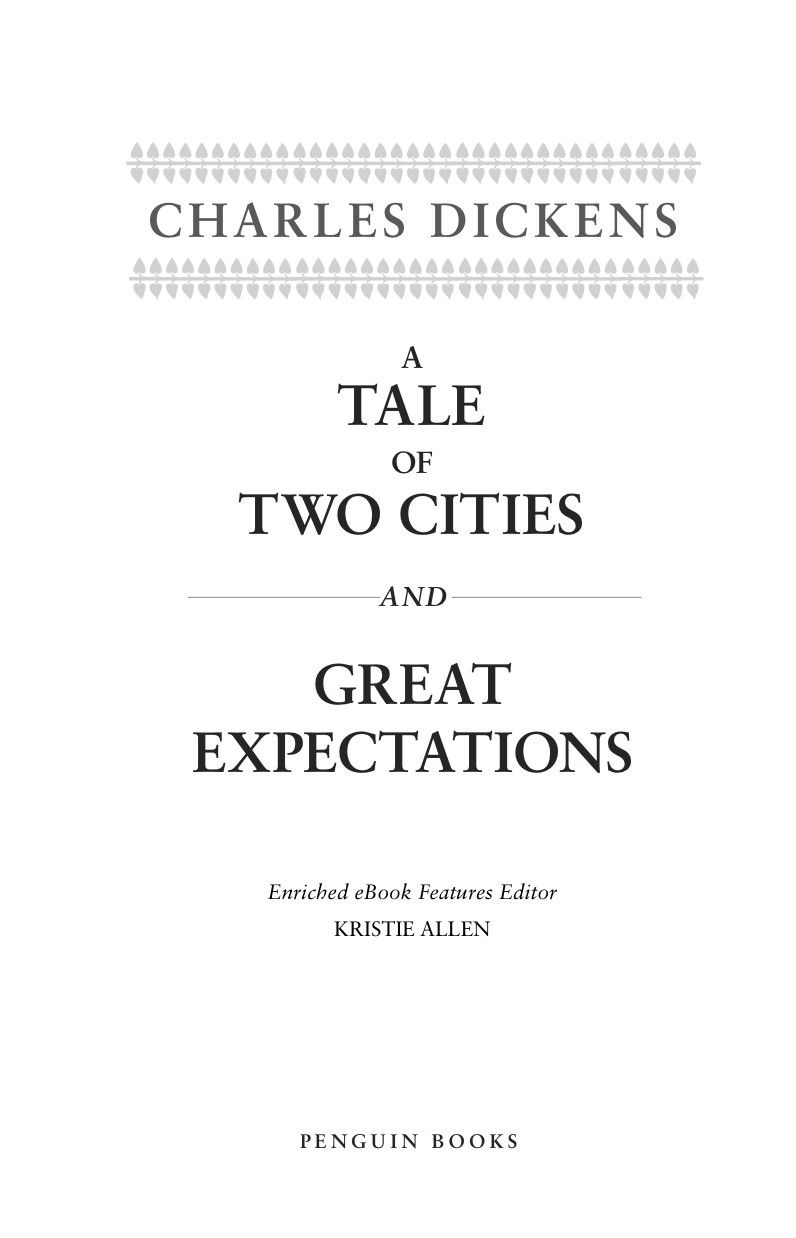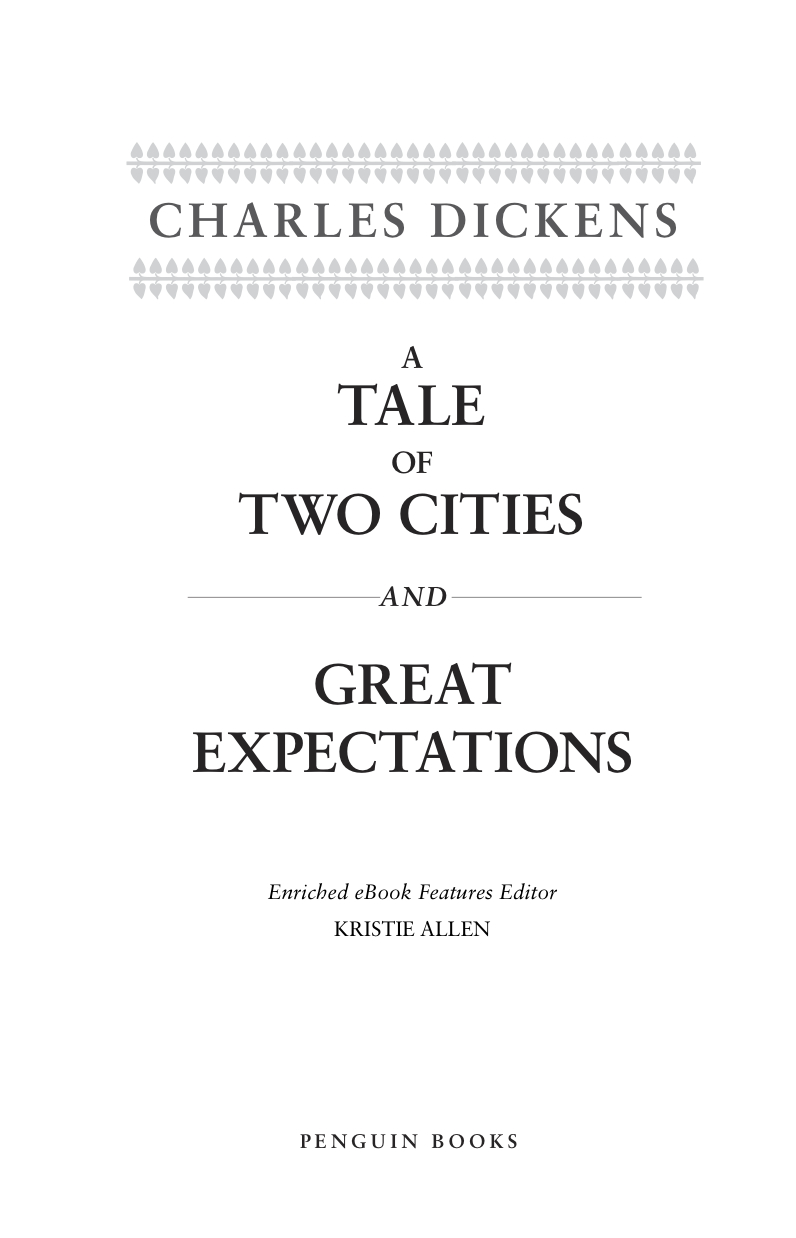A Tale of Two Cities and Great Expectations (Oprah's Book Club)

Table of Contents
Title Page
Copyright Page
A TALE OF TWO CITIES
Book the First: Recalled to Life
CHAPTER 1 - The Period
CHAPTER 2 - The Mail
CHAPTER 3 - The Night Shadows
CHAPTER 4 - The Preparation
CHAPTER 5 - The Wine-Shop
CHAPTER 6 - The Shoemaker
Book the Second: The Golden Thread
CHAPTER 1 - Five Years Later
CHAPTER 2 - A Sight
CHAPTER 3 - A Disappointment
CHAPTER 4 - Congratulatory
CHAPTER 5 - The Jackal
CHAPTER 6 - Hundreds of People
CHAPTER 7 - Monsieur the Marquis in Town
CHAPTER 8 - Monsieur the Marquis in the Country
CHAPTER 9 - The Gorgon’s Head
CHAPTER 10 - Two Promises
CHAPTER 11 - A Companion Picture
CHAPTER 12 - The Fellow of Delicacy
CHAPTER 13 - The Fellow of No Delicacy
CHAPTER 14 - The Honest Tradesman
CHAPTER 15 - Knitting
CHAPTER 16 - Still Knitting
CHAPTER 17 - One Night
CHAPTER 18 - Nine Days
CHAPTER 19 - An Opinion
CHAPTER 20 - A Plea
CHAPTER 21 - Echoing Footsteps
CHAPTER 22 - The Sea Still Rises
CHAPTER 23 - Fire Rises
CHAPTER 24 - Drawn to the Loadstone Rock
Book the Third: The Track of a Storm
CHAPTER 1 - In Secret
CHAPTER 2 - The Grindstone
CHAPTER 3 - The Shadow
CHAPTER 4 - Calm in Storm
CHAPTER 5 - The Wood-Sawyer
CHAPTER 6 - Triumph
CHAPTER 7 - A Knock at the Door
CHAPTER 8 - A Hand at Cards
CHAPTER 9 - The Game Made
CHAPTER 10 - The Substance of the Shadow
CHAPTER 11 - Dusk
CHAPTER 12 - Darkness
CHAPTER 13 - Fifty-two
CHAPTER 14 - The Knitting Done
CHAPTER 15 - The Footsteps Die Out For Ever
PENGUIN ENRICHED EBOOK FEATURES
Early Reception of A Tale of Two Cities
Psychology in A Tale of Two Cities
Dickens and Melodrama
Dickens and Alcohol
Dickens and Prisons
Illustrations of Eighteenth-Century Fashion and Culture and Dickens’s Victorian World
Further Reading
Filmography for Dickens’s Novels
GREAT EXPECTATIONS
VOLUME I
CHAPTER I
CHAPTER II
CHAPTER III
CHAPTER IV
CHAPTER V
CHAPTER VI
CHAPTER VII
CHAPTER VIII
CHAPTER IX
CHAPTER X
CHAPTER XI
CHAPTER XII
CHAPTER XIII
CHAPTER XIV
CHAPTER XV
CHAPTER XVI
CHAPTER XVII
CHAPTER XVIII
CHAPTER XIX
VOLUME II
CHAPTER I
CHAPTER II
CHAPTER III
CHAPTER IV
CHAPTER V
CHAPTER VI
CHAPTER VII
CHAPTER VIII
CHAPTER IX
CHAPTER X
CHAPTER XI
CHAPTER XII
CHAPTER XIII
CHAPTER XIV
CHAPTER XV
CHAPTER XVI
CHAPTER XVII
CHAPTER XVIII
CHAPTER XIX
CHAPTER XX
VOLUME III
CHAPTER I
CHAPTER II
CHAPTER III
CHAPTER IV
CHAPTER V
CHAPTER VI
CHAPTER VII
CHAPTER VIII
CHAPTER IX
CHAPTER X
CHAPTER XI
CHAPTER XII
CHAPTER XIII
CHAPTER XIV
CHAPTER XV
CHAPTER XVI
CHAPTER XVII
CHAPTER XVIII
CHAPTER XIX
CHAPTER XX
Appendix: - The Ending as Originally Conceived
PENGUIN ENRICHED EBOOK FEATURES
Early Reception of Great Expectations
What Is “Dickensian”?
Gothic Elements in Dickens
Dickens and Victorian Servants
Dickens Sites to Visit in England
Suggested Further Reading: Victorian Fiction
BookishMall.com
A TALE OF TWO CITIES and GREAT EXPECTATIONS
CHARLES DICKENS was born at Portsmouth on 7 February 1812, the second of eight children. Dickens’s childhood experiences were similar to those depicted in David Copperfield. His father, who was a government clerk, was imprisoned for debt and Dickens was briefly sent to work in a blacking warehouse at the age of twelve. He received little formal education, but taught himself shorthand and became a reporter of parliamentary debates for the Morning Chronicle . He began to publish sketches in various periodicals, which were subsequently republished as Sketches by Boz. The Pickwick Papers was published in 1836-7 and after a slow start became a publishing phenomenon and Dickens’s characters the centre of a popular cult. Part of the secret of his success was the method of cheap serial publication which Dickens used for all his novels. He began Oliver Twist in 1837, followed by Nicholas Nickleby (1838-9) and The Old Curiosity Shop (1840-41). After finishing Barnaby Rudge (1841) Dickens set off for America; he went full of enthusiasm for the young republic but, in spite of a triumphant reception, he returned disillusioned. His experiences are recorded in American Notes (1842). Martin Chuzzlewit (1843-4) did not repeat its predecessors’ success, but this was quickly redressed by the huge popularity of the Christmas Books, of which the first, A Christmas Carol, appeared in 1843. During 1844-6 Dickens travelled abroad and he began Dombey and Son (1846-8) while in Switzerland. This and David Copperfield (1849-50) were more serious in theme and more carefully planned than his early novels. In later works, such as Bleak House (1852-3) and Little Dorrit (1855-7), Dickens’s social criticism became more radical and his comedy more savage. In 1850 Dickens started the weekly periodical Household Words, succeeded in 1859 by All the Year Round; in these he published Hard Times (1854), A Tale of Two Cities (1859), and Great Expectations (1860-61). Dickens’s health was failing during the 1860s and the physical strain of the public readings which he began in 1858 hastened his decline, although Our Mutual Friend (1864-5) retained some of his best comedy. His last novel, The Mystery of Edwin Drood, was never completed and he died on 9 June 1870. Public grief at his death was considerable and he was buried in the Poets’ Corner of Westminster Abbey.
KRISTIE ALLEN holds a PhD from Rutgers University and has taught Romantic and Victorian literature at Rutgers University and Macalester College. In addition to writing on Charles Dickens, she has published articles on George Eliot's The Mill on the Floss and on Victorian melodramas.

BookishMall.com
Published by the Penguin Group
Penguin Group (USA) Inc., 375 Hudson Street, New York, New York 10014, U.S.A.
Penguin Group (Canada), 90 Eglinton Avenue East, Suite 700, Toronto, Ontario, Canada M4P 2Y3
(a division of Pearson Penguin Canada Inc.)
Penguin Books Ltd, 80 Strand, London WC2R oRL, England
Penguin Ireland, 25 St Stephen’s Green, Dublin 2, Ireland (a division of Penguin Books Ltd)
Penguin Group (Australia), 250 Camberwell Road, Camberwell, Victoria 3124, Australia
(a division of Pearson Australia Group Pty Ltd)
Penguin Books India Pvt Ltd, 11 Community Centre, Panchsheel Park,
New Delhi – 110 017, India
Penguin Group (NZ), 67 Apollo Drive, Rosedale,
North Shore 0632, New Zealand (a division of Pearson New Zealand Ltd)
Penguin Books (South Africa) (Pty) Ltd, 24 Sturdee Avenue, Rosebank, Johannesburg 2196, South Africa
Penguin Books Ltd, Registered Offices:
80 Strand, London WC2R oRL, England
A TALE OF TWO CITIES
First published in Great Britain by Chapman and Hall 1859
First published in the United States of America by T. B. Peterson & Brothers 1859
Originally published in serial form in All the Year Round 1859
GREAT EXPECTATIONS
First published in Great Britain by Chapman and Hall 1861
First published in the United States of America by T. B. Peterson & Brothers 1861
Originally published in serial form in All the Year Round 1860-1861
This two-book edition published in Penguin Books 2010
Penguin Enriched eBook Features copyright © Kristie Allen, 2008, 2010
All rights reserved
eISBN : 978-1-101-49951-1
The scanning, uploading and distribution of this book via the Internet or via any other means without the permission of the publisher is illegal and punishable by law. Please purchase only authorized electronic editions, and do not participate in or encourage electronic piracy of copyrighted materials. Your support of the author’s rights is appreciated.
http://us.penguingroup.com
Notes on the Texts
A TALE OF TWO CITIES
This edition of A Tale of Two Cities uses the text as it appeared in its first serial publication in Dickens’s periodical All the Year Round in 1859. Only a few emendations have been made.
GREAT EXPECTATIONS
The present edition has been reprinted from Great Expectations by Charles Dickens (Penguin Classics, 2003), with an introduction by David Trotter and edited and with notes by Charlotte Mitchell.
The appendix prints the ending of the novel as Dickens originally conceived it.
A TALE OF TWO CITIES
Book the First
Recalled to Life
CHAPTER 1
The Period
It was the best of times, it was the worst of times, it was the age of wisdom, it was the age of foolishness, it was the epoch of belief, it was the epoch of incredulity, it was the season of Light, it was the season of Darkness, it was the spring of hope, it was the winter of despair, we had everything before us, we had nothing before us, we were all going direct to Heaven, we were all going direct the other way – in short, the period was so far like the present period, that some of its noisiest authorities insisted on its being received, for good or for evil, in the superlative degree of comparison only.
There were a king with a large jaw and a queen with a plain face, on the throne of England; there were a king with a large jaw and a queen with a fair face, on the throne of France. In both countries it was clearer than crystal to the lords of the State preserves of loaves and fishes, that things in general were settled for ever.
It was the year of Our Lord one thousand seven hundred and seventy-five. Spiritual revelations were conceded to England at that favoured period, as at this.
1 comment